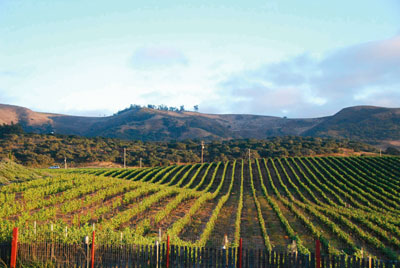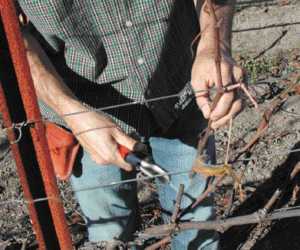 A high percentage of my consulting business comes from wine lovers wanting to buy vineyard property. The story is usually the same: about ten years from retirement, successful in business, getting tired of pushing paper in the rat race, they want to get back to an agricultural way of life to recapture a lost piece of their soul. Some believe that the best way to appreciate wine is to grow it themselves. Others may believe that being “in the business” will give them more opportunities to enjoy wine. All potential vineyard owners have one thing in common, though. None expect the process to be so complicated, expensive and time consuming. The purpose of this article is to make full disclosure. After reading it, you should have a much deeper understanding of the responsibilities, pitfalls and economic impacts of buying land for vineyard establishment. If the caveats dissuade you from planting a vineyard, I will have saved you a lot of money and disappointment. However, if after reading this article, you are still interested in starting a vineyard, you are a true believer and will likely succeed.
A high percentage of my consulting business comes from wine lovers wanting to buy vineyard property. The story is usually the same: about ten years from retirement, successful in business, getting tired of pushing paper in the rat race, they want to get back to an agricultural way of life to recapture a lost piece of their soul. Some believe that the best way to appreciate wine is to grow it themselves. Others may believe that being “in the business” will give them more opportunities to enjoy wine. All potential vineyard owners have one thing in common, though. None expect the process to be so complicated, expensive and time consuming. The purpose of this article is to make full disclosure. After reading it, you should have a much deeper understanding of the responsibilities, pitfalls and economic impacts of buying land for vineyard establishment. If the caveats dissuade you from planting a vineyard, I will have saved you a lot of money and disappointment. However, if after reading this article, you are still interested in starting a vineyard, you are a true believer and will likely succeed.
Why do I want to grow grapes? This may seem like a simple question, but it’s one that I force upon my new clients, asking them to dig deep and discover the truth that may lie beneath the initial impulse of wanting to grow vines on their property. Let me be clear: The cost and effort to design, plant and maintain a vineyard is clearly prohibitive to most people that want a vineyard for landscaping purposes.
Landscaping in this context means that the vines are planted to:
•Fill in empty space in the yard
•Remind you of France or Italy
•Show your friends and neighbors you have a vineyard
• Increase property value
The key here is to be honest with yourself. There are plenty of fruit trees or other ornamentals that will be just as pretty (but perhaps less romantic) as a vineyard, and will require far less maintenance, inputs and upkeep cost. This warning comes from years of dealing with customers who have let their vineyards degrade to a point where the fruit does not make sound wine, and they feel burdened by the responsibility of vineyard ownership.
The Right Reasons
Without the cost of land, an acre of vineyard can cost up to $20,000 to plant. For the same money you could purchase thousands of bottles of fine wine and fill a cellar for many years of wine drinking. Without commitment, the right help and the right piece of dirt, you may plant a vineyard and never produce a sound bottle of wine. Here’s my list of reasons that you should pursue vineyard land for wine production:
• Your enjoyment of wine has peaked after decades of travel, tasting, note taking, collecting and pursuing knowledge of wine.
• You are physically able to do hard physical labor in the vineyard, and believe doing so will feed your soul in a way that your current vocation could not. Alternatively, you have a vineyard staff that can do the work under your close supervision.
• You’ve been a home winemaker for a number of vintages, and have found that you just can’t get the quality of fruit that you want.
• You believe that your passion and commitment will lead to a sense of accomplishment. You believe you can grow better fruit than other local vineyards.
• You have been working hard to have the finances to pursue your dream.
There is a reason that most professional winemakers do not own their own vineyards. The cost and time required for growing quality fruit keeps them from the cellar and from promoting their wines. My advice to clients is this: if you have a source of quality fruit that you can buy at a reasonable cost, you may want to continue purchasing the fruit and let someone else farm winegrapes for you.
Now that I’ve scared most of you away from planting a vineyard, I will attempt to guide the initiated (perhaps insane) viticulturists through the process of assessing sites for vineyard development. I feel confident that you are aware of the financial and labor challenges, so now we will focus on the nuts and bolts of looking for a vineyard site.
Here are some questions you should ask yourself, and answers that attempt to look at all sides of the issue:
Home Winemaking or Commercial Production?
This decision will impact the size of the property you are seeking, and help you define the region where you would like to grow. Most home winemaking vineyards are an acre or less, and most commercial vineyards are 5 acres or more. If you’re not sure which way you want to go, my usual recommendation is to start with an acre. An acre of vines can be farmed by a single devoted individual, and will produce enough crop in its third or fourth year to give you an excellent indication of wine quality from that locale. If you are going commercial make sure you have a potential audience for your wines, or winemakers that have agreed to buy the fruit before you plant. Of course you want to make sure that the land is suitable for premium wine production. Vineyards are too much work to plan and install on a site that will produce mediocre wine.
Time and Money
A vineyard is not an asset. Most banks won’t even add one dollar of value to your property for producing vineyards, even successful commercial operations. Of course, the truth is that a vineyard does add value to a property: both real and imagined, but don’t expect to retire on the money that will be produced by your new winegrape project. Set a budget from disposable income, not from investment accounts. After you set a budget, try not to freak out when the final numbers double. A vineyard tends to be a big money pit for the first three years, and it hurts to watch the money go out constantly without any fruit coming back to you. In general, if you are at all concerned about the cost of finding vineyard land, establishment and maintenance, this is not the hobby for you. At the risk of sounding elitist: if you shudder at the idea of maintaining a Ferrari, a vineyard will likely wreck your finances; both Italian sportscars and vineyards are temperamental and in need of constant professional tinkering in order for them to produce pleasurable results. There are devoted individuals out there that have the time and strong back to do the work themselves. They can minimize costs and grow great fruit. I suspect they are in the minority, though, so expect a great vineyard to cost a great amount of time and money.
Will Grapes Grow and Produce Good Wine?
If you’ve reached this part of the article, you are a brave soul and possess a personality that is not frightened by a challenge. I tried to scare you off but you kept coming back for more! Now we get to the fun stuff. The details of soil and water testing are included a little further down, but for now let me offer the following advice: Let others spend their time and money being pioneers in new regions. Find a place in the world that makes wines you LOVE to drink, where there’s available property that fits your budget and neighbors that can help you with your vineyard. If you love Riesling, you may want to look at the Finger Lakes. Delicious native grapes like Norton do very well in Missouri, where you can find spectacular barbecue to match. Zinfandel lovers may be able to find a plot in the Sierra Foothills of California or even Lodi (a good place to be stuck, for Lodi has one of the best grower outreach programs in the world). Up and coming regions offer good value for land: areas in Paso Robles, Santa Barbara and Monterey are still transitioning from production agriculture to viticulture, and offer an excellent balance of land value and a supportive, friendly industry. The costs associated with vineyard development should lead you to this conclusion: Start a vineyard where great wine is grown and there is an existing viticultural infrastructure with which you can network.
The Key Factors
Get a pro involved early
Ask around to see who’s making the best wine in the area, and then visit that person with gifts of fine wine or take them out to eat. You’ll be surprised how a great bottle of Grand Cru Burgundy or a medium-rare veal chop can affect the mood of any winegrower. If they favor Budweiser and Burger King over Clos de la Roche and duck confit, search for another consultant. Show them you are serious, passionate, knowledgeable and financially solvent and they will usually be willing to talk about your project. Bring soil samples, water samples, etc., tell them your favorite style of wines and ask them how they would proceed to grow that type of wine locally. Become excellent customers of local wineries, attend wine association meetings, volunteer at events, become an important element in the local wine community.
Soil testing
Easy stuff: dig a four foot deep hole with a shovel, or preferably, a backhoe. Taking a central sample on a small backyard property may be enough, but if you see changes in soil structure, color or native vegetation, take additional soil samples from there too. Take samples from 12–24” (~31–62 cm) and 24–36” (62–93 cm) depths, label them individually in big, 1.0-gallon (3.8-L) ziplock bags and UPS or FedEx them off to an agricultural lab. Ask for comprehensive soil analysis for preplant winegrape production, and also ask for preplant amendment recommendations. This will cost you about $130 per sample, and should be done before making an offer on any property (ditto for water testing).
Water testing
If you are planning on using irrigation, take a raw sample of the water source and ask for an irrigation water suitability test (note that the test is for winegrape production). The water can be tested for a myriad of chemicals, nutrients, benefits and potential problems. The following factors should be measured in the test: alkalinity, bicarbonate, boron, calcium, carbonate, chloride, copper, electrical conductivity, fluoride, gypsum requirement, hydroxide, iron, magnesium, manganese, nitrate, pH, potassium, sodium, SAR, sulfate, total dissolved solids, total hardness and zinc. One quart (~1 L) of water is usually required. Use a secure, sterile plastic bottle with a sturdy closure, and make sure to run your well or water source for about 10 minutes or more before taking the sample, to assure that it has flushed all contaminants. Again, I will stress the importance of personally completing soil and water testing before bidding on a potential vineyard property. I suggest not trusting samples provided from real estate companies or consultants. For the money you are about to spend, it’s worth it to do the sampling yourself, or hire a viticulturist you trust to take care of it under your supervision.
Soil and vertebrate pests
Once you get the soil tests back, discuss them with a local grower or call the lab to have anything mysterious explained. Most folks don’t know the importance of cation exchange capacity or boron deficiency, but with the right consultant, it usually comes down to adding something to the soil pre-plant, or using a yearly fertilizer or compost. No soil is perfect, but you may want to pass on a site that has too many red flags on the soil report. Know the details of your soil’s chemistry before bidding on a property. Also, look around at the open land and the neighbors’ open land. Is it pocked with gopher mounds? Are there ground squirrels? Deer and no deer fence? Turkeys? Ostriches? If there are more than five gopher mounds per acre, you may have a potential problem. You can ask for the gophers/squirrels to be professionally exterminated as a condition of purchase. If there are deer in the area, deer fencing (you may be surprised how high a deer will jump for ripe winegrapes) is a must. Deer fencing will also keep other animals out and your dogs in. Dogs are important for a vineyard, as they can put pressure on birds, squirrels, coyotes and gophers.
There is perhaps no way to make a dog happier than giving them the job of protecting a vineyard. Each vineyard problem has a specific breed that can help. For my taste, a border collie is an excellent all-around vineyard dog as long as you have enough property to keep the breed busy.
Disease
Know the potential mildew and rot pressures that occur on your potential site, and ask local growers what they spray, what equipment they use, how often they spray, where they buy their materials and what permits are necessary. You may also want to ask local winegrowers about disease issues such as phylloxera, eutypa, Pierce’s disease, nematodes, special insect pests and the likes so you can predict potential problems in the vineyard and act to minimize impact. Finding an area free from Pierce’s disease and phylloxera may be your best bet for a long term vineyard investment.
Aspect
Aspect refers to the lay of the land and how hillsides are oriented to geographical features and the sun. Don’t worry too much about finding that south by southwest facing hillside you learned about in France. Most sites in the U.S. don’t need a special aspect to get adequate ripeness. I do believe that hillside sites tend to grow better wine as a result of drainage and a reduction in vigor. Try to plant on a site that is slightly elevated and sloping, and be careful not to plant at the bottom of a canyon or basin-type area that may collect cold air and frost the vines in spring. I plant my rows in a north-south orientation, and recommend the same to my clients, unless it makes the rows unsafe for tractors or equipment.
Drainage and erosion
The last thing you want after installing a vineyard is for heavy rains to wash away your soil. Winter cover crop is a solution that will also help the soil’s health when the green material is cultivated into the ground.
Note which way water and rainfall will drain off of your site, and make sure to protect freshly turned hillside earth from rains by use of a layer of straw, planted grasses, sandbags or subsoil drain systems (sometimes called French drains). Young vineyards that ripped or cultivated the soil preplant are most susceptible to this kind of erosion. Heavy machinery operators that specialize in agricultural grading can be hired to solve these problems for you before planting.
Neighbors and fellow winegrowers
We’ve gone over this, but make sure the property is near existing, quality wine production, and that your neighbors are friendly and willing to share their expertise. Who knows, if you’re nice enough they may even let you borrow their tractor and spray rig!
Fencing, equipment and storage
You need a covered space to keep a tractor, ATV, spray equipment, buckets, gloves and tools. If the property has an existing barn or covered area, make sure it’s big enough to enclose all of your future farming equipment. All chemicals must be kept in a locked chest or closet and don’t forget about bulky items like bird netting, fertilizers, picking bins, and similar sized gear. It’s also nice to have a shaded area with a picnic table for vineyard workers to have lunch.
Follow through and installation
A few final questions arise: do you want to try to install the vineyard yourself or hire a company for a pro install? Do you use the cheapest materials and replace the trellising every 10 years or do you buy the expensive stuff that may last 30? Plan on one full time worker for a 1–2 acre vineyard if you don’t plan to do the work yourself. It takes about 8–9 full time, 48 hour work-week employees 6 months to finish our farming here at Clos Pepe, but we go overboard on fine tuning and human touch. There are always new mechanical devices being invented to remove humans from winegrape farming, but I’m guessing some of that sweaty hand labor is exactly what you dream of after 10 hours of pushing paper at a desk job. I do believe that the human factor, and passion specifically, is evident in a finished wine, and the more of yourself you put into the vineyard, the better the wine will taste.







